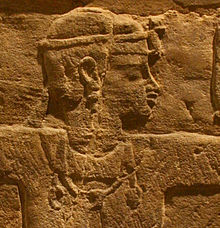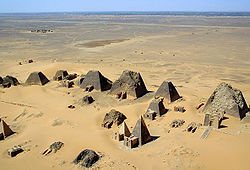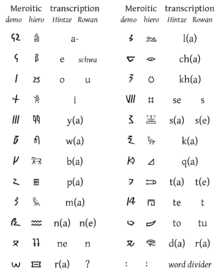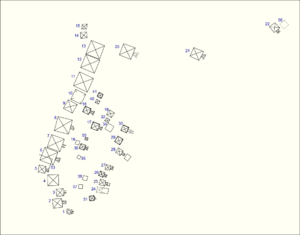- Meroë
-
Archaeological Sites of the Island of Meroe * UNESCO World Heritage SiteCountry Sudan Type Cultural Criteria ii, iii, vi, v Reference 1336 Region ** Africa Inscription history Inscription 2011 (35th Session) * Name as inscribed on World Heritage List
** Region as classified by UNESCO Meroë is northeast of Khartoum (center right).
Meroë is northeast of Khartoum (center right).
Coordinates: 16°56′N 33°45′E / 16.94°N 33.75°E
Meroë (also spelled Meroe[1][2]) Meroitic: Medewi or Bedewi; Arabic: مرواه Meruwah and مروى Meruwi) is an ancient city on the east bank of the Nile about 6 km north-east of the Kabushiya station near Shendi, Sudan, approximately 200 km north-east of Khartoum. Near the site are a group of villages called Bagrawiyah. This city was the capital of the Kingdom of Kush for several centuries. The Kushitic Kingdom of Meroë gave its name to the Island of Meroë, which was the modern region of Butana, a region bounded by the Nile (from the Atbarah River to Khartoum), the Atbarah, Ethiopia, and the Blue Nile.
The city of Meroë was on the edge of Butana and there were two other Meroitic cities in Butana, Musawwarat es-Sufra, and Naqa.[3][4]
The site of the city of Meroë is marked by more than two hundred pyramids in three groups, of which many are in ruins. They are identified as Nubian pyramids because of their distinctive size and proportions.
Contents
History
Meroë was the southern capitol of the Napata/Meroitic Kingdom, that spanned the period c. 800 BC - c. 350 AD. According to partially deciphered Meroitic texts, the name of the city was Medewi or Bedewi (Török, 1998).
Excavations revealed evidence of important, high ranking Kushite burials, from the Napata Period (c. 800 - c. 280 BC) in the vicinity of the settlement called the Western cemetery.
The culture of Meroë developed from the Twenty-fifth Dynasty of Ancient Egypt, which originated in Kush. The importance of the town gradually increased from the beginning of the Meroitic Period, especially from the reign of Arrakkamani (c. 280 BC) when the royal burial ground was transferred to Meroë from Napata (Jebel Barkal).
 Relief of a ruler, a Candace of Meroë named Kandake Amanitore
Relief of a ruler, a Candace of Meroë named Kandake Amanitore
Rome's capture of Egypt led to border clashes and expansion by both Meroë and Rome.[5] It appears that during the skirmishes that ensued, Meroe often came out the better, sacking settlements in and near Aswan, even looting a head from a statue of the emperor Augustus and burying it under their temple steps[6] Back and forth conflict eventually lead to both sides meeting at the Island of Samos, where a peace treaty (that was surprisingly favorable to the Kushites) had been reached through emperor Augustus. Meroe eventually settled down to a healthy trading relationship with Rome and the Mediterranean.[citation needed] However, the kingdom of Meroe began to fade as a power by the 1st or 2nd century AD, sapped by the war with Roman Egypt and the decline of its traditional industries.[7]
Meroe is mentioned succinctly in the 1st century AD Periplus of the Erythraean Sea:
"2. On the right-hand coast next below Berenice is the country of the Berbers. Along the shore are the Fish-Eaters, living in scattered caves in the narrow valleys. Farther inland are the Berbers, and beyond them the Wild-flesh-Eaters and Calf-Eaters, each tribe governed by its chief; and behind them, farther inland, in the country towards the west, there lies a city called Meroe."—Periplus of the Erythraean Sea, Chap.2The last period of the city is marked by the victory stele of an unnamed ruler of Aksum (almost certainly Ezana) erected at the site of Meroë; from his description, in Greek, that he was "King of the Aksumites and the Omerites," (i.e. of Aksum and Himyar) it is likely this king ruled sometime around 330. Two more inscriptions in Ge'ez script have been found on nearby pyramids; it is uncertain whether they are contemporary with the royal stele, or belong to a later date.
Civilization
Meroë was the base of a flourishing kingdom whose wealth was due to a strong iron industry, and international trade involving India and China.[8] So much metalworking went on in Meroë, through the working of bloomeries and possibly blast furnaces, that it has even been called "the Birmingham of Africa" because of its vast production and trade of iron to the rest of Africa, and other international trade partners.
At the time, iron was one of the most important metals worldwide, and Meroitic metalworkers were among the best in the world. Meroë also exported textiles and jewelry. Their textiles were based on cotton and working on this product reached its highest achievement in Nubia around 400 BC. Furthermore, Nubia was very rich in gold. It is possible that the Egyptian word for gold, nub, was the source of name of Nubia. Trade in "exotic" animals from farther south in Africa was another feature of their economy.
The Egyptian import, the water-moving wheel, the sakia, was used to move water, in conjunction with irrigation, to increase crop production.[9]
At the peak, the rulers of Meroë controlled the Nile valley north to south over a straight line distance of more than 1,000 km (620 mi).[10]
The King of Meroë was an autocrat ruler who shared his authority only with the Queen Mother, or Candace. However, the role of the Queen Mother remains obscure. The administration consisted of treasurers, seal bearers, heads of archives, and chief scribes, among others.
By the 3rd century BC a new indigenous alphabet, the Meroitic, consisting of twenty-three letters, replaced Egyptian script. The Meroitic script is an alphabetic script originally derived from Egyptian hieroglyphs, used to write the Meroitic language of the Kingdom of Meroë/Kush. It was developed in the Napatan Period (about 700 - 300 BC), and first appears in the 2nd century BC. For a time, it was also possibly used to write the Nubian language of the successor Nubian kingdoms.[11]
Although the people of Meroë also had southern deities such as Apedemak, the lion-son of Sekhmet (or Bast, depending upon the region), they also continued worshipping Egyptian deities they had brought with them, such as Amun, Tefnut, Horus, Isis, Thoth, and Satis, though to a lesser extent.
Archaeology
- For a list of pyramids and their owners see Pyramids of Meroe (Begarawiyah)
The site of Meroë was discovered in 1821 by the French mineralogist Frédéric Cailliaud (1787–1869), who published an illustrated in-folio describing the ruins. Some treasure-hunting excavations were executed on a small scale in 1834 by Giuseppe Ferlini, who discovered (or professed to discover) various antiquities, chiefly in the form of jewelry, now in the museums of Berlin and Munich.
The ruins were examined more carefully in 1844 by Karl Richard Lepsius, who brought many plans, sketches, and copies, besides actual antiquities, to Berlin.
Further excavations were carried on by E. A. Wallis Budge in the years 1902 and 1905, the results of which are recorded in his work, The Egyptian Sudan: its History and Monuments (London, 1907). Troops furnished by Sir Reginald Wingate, governor of Sudan, made paths to and between the pyramids, and sank shafts.
It was found that the pyramids were commonly built over sepulchral chambers, containing the remains of bodies, either burned, or buried without being mummified. The most interesting objects found were the reliefs on the chapel walls, already described by Lepsius, which present the names and representations of their queens, Candaces, or the Nubian Kentakes, some kings, and some chapters of the Book of the Dead; some stelae with inscriptions in the Meroitic language; and some vessels of metal and earthenware. The best of the reliefs were taken down stone by stone in 1905, and set up partly in the British Museum, and partly in the museum at Khartoum.
In 1910, in consequence of a report by Archibald Sayce, excavations were commenced in the mounds of the town, and in the necropolis, by John Garstang, on behalf of the University of Liverpool. Garstang discovered the ruins of a palace and several temples built by the Meroite rulers.
Modern archaeology in Sudan has been difficult because of the on-going civil war.
World Heritage Listing
In June 2011, the Archeological Sites of Meroë were listed by UNESCO as World Heritage Sites.[12]
See also
Notes
- ^ Meroe, Encyclopedia Britannica, v.15, p.197, Encyclopedia Britannica Inc., William Benton, London, 1969.
- ^ Meroe, Encyclopedia Americana, v.18, p.677, Encyclopedia Americana Corporation, New York, 1961.
- ^ "The Island of Meroe", UNESCO World Heritage
- ^ Osman Elkhair and Imad-eldin Ali, Ancient Meroe Site: Naqa and Musawwarat es-Sufra (recent photographs)
- ^ In 23 BC the Roman governor of Egypt, Publius Petronius, invaded Nubia in response to a Nubian attack on southern Egypt, pillaging the north of the region and sacking Napata (22 BC) before returning north.
- ^ "Bronze head of Augustus". British Museum. 1999. http://www.britishmuseum.org/explore/highlights/highlight_objects/gr/b/bronze_head_of_augustus.aspx. Retrieved 2008-06-14.
- ^ "Nubia", BBC World Service
- ^ Lecture 30: ANCIENT AFRICA Lectures contributed by Steve Stofferan and Sarah Wood, Purdue University
- ^ Trudy Ring, Robert M. Salkin, Sharon La Boda, International Dictionary of Historic Places
- ^ Adams, Nubia, p. 302.
- ^ "Meroe: Writing", Digital Egypt, University College, London
- ^ "World Heritage Sites: Meröe". http://whc.unesco.org/en/list/1336/multiple=1&unique_number=1760. Retrieved 14 July 2011.
References
 This article incorporates text from a publication now in the public domain: Chisholm, Hugh, ed (1911). Encyclopædia Britannica (11th ed.). Cambridge University Press.
This article incorporates text from a publication now in the public domain: Chisholm, Hugh, ed (1911). Encyclopædia Britannica (11th ed.). Cambridge University Press.- Bianchi, Steven (1994). The Nubians: People of the ancient Nile. Brookfield, Conn.: Millbrook Press. ISBN 1562943561.
- Davidson, Basil (1966). Africa, History of A Continent. London: Weidenfeld & Nicolson. pp. 41–58.
- Adams, W. Y. (1977), Nubia: Corridor to Africa, London: Allen Lane, pp. 294–432.
- Shinnie, P. L. (1967). Meroe, a civilization of Sudan. Ancient People and Places. 55. London/New York: Thames and Hudson.
- Török, László (1997). The Kingdom of Kush: Handbook of the Napatan-Meroitic Civilization. Handbuch der Orientalistik. Erste Abteilung, Nahe und der Mittlere Osten. 31. Leiden: Brill. ISBN 9004104488.
External links
- LearningSites.com - Gebel Barkal
- UNESCO World Heritage - Gebel Barkal and the Sites of the Napatan Region
- Nubia Museum - Merotic Empire
- (French) Voyage au pays des pharaons noirs Travel in Sudan and notes on Nubian history
Categories:- Ancient cities
- Kingdom of Kush
- Kings of Kush
- Queens of Kush
- Dynasties of ancient Egypt
- Roman frontiers
- History of Nubia
- African civilizations
- Former populated places in Sudan
- Archaeological sites in Sudan
Wikimedia Foundation. 2010.




